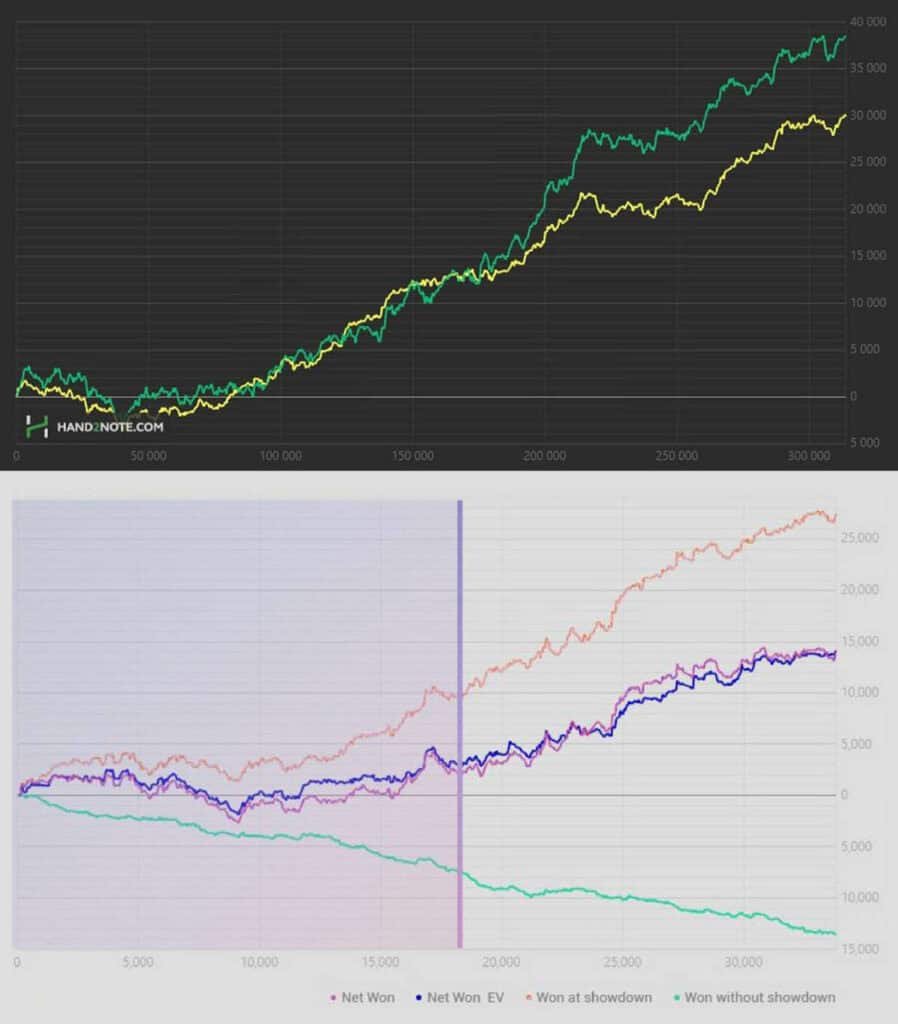
How to Evaluate and Compare Poker Bot Options Before Buying
We’ve gone from checking humans aren’t bots to checking bots are human (enough). With all the AI poker bots cropping up on the market, it can be tricky knowing how to compare and evaluate AI poker bot options before buying.
My advice? You need a poker bot that does more than just “play” based on some internal strategies and profiles. You need a system so advanced that it can actually think like a human.
When using the poker bots offered on the market in 2025, it can be easy to lose your deposit; The sad truth is that many of these bots tend to over-promise and under-deliver.
Legacy poker bots still work and can even show some short-term profits until you reach real-world levels of 100, 200, or 500,000+ hands. We’ll mention them, but we won’t cover them in this review.
Today we’ll look at how to evaluate and compare poker bot options (including “AI” bots) before purchasing so you can enjoy the most advanced, research-backed one.
The Current State (2025) of AI Poker Bots
Most people hear about “poker AI” for the first time in connection with Libratus (CMU, 2017) and then later with Pluribus (Meta/Facebook AI + CMU, 2019) — systems which do not only hold their own, but set a new standard in no-limit hold’em for using game-theoretic methods like CFR, and scalable equilibrium approximations. Brilliant research and applied science, granted, but for a controlled environment, not for breaking and entering into live poker rooms, with their messy customer base, protective barriers, and exposure to detection.
Subject interest has exploded since then. On the commercial side, a very few vendors are now marketing AI poker bots, but much of the stuff which is actually coming out appears to be piled up on top of OpenHoldem-style frameworks: computer-vision/screen parsing to read the table, together with scripted rules and condition trees, which fire off actions, at times garnished with Monte Carlo rollouts, and hand-range presets, or light heuristics.
The self-described AI offerings promise auto-reads, based on computer vision, for example, solver-derived lines, some pool adaptation by simple stats and tendencies, and perhaps multi-tabling, together with a few stealth or anti-detection toggles, while underneath them all, they are rule engines, with automation properties, rather than end to end, data-trained agents, in the sense of Libratus and Pluribus.
What to Look for When Evaluating AI Poker Bots
Okay, so where does that leave you? How do you know when to buy one of these tools?
1. Techy Realism: How “Human-y” Is the Bot’s Play?
Obviously, before we go any further, we want to check the bot thinks like a real, sharp human player. While many of these solvers are said to be modeled on Game Theory Optimal (GTO), any person well-versed in GTO knows there’s so much nuance entering into it. It’s context-dependent, think-fast and no-holds-barred.
How do I make sure the bot lives up to that?
- Adaptive Strategy: Test with varied opponent types in mind – tight, aggressive, etc. –
and see how well the AI adapts (or does it tend to be more of a one-trick pony?). - Learning Efficiency: How many hands does it need to start spotting patterns? And can you afford those extra three, five, seven hands, or are you wasting time?
- Error Rates: Eyes peeled for strange leaks, folds, and over-bluffing, folks.
Much as we still think in terms of us vs. them, it’s time we realized the most solid poker AI mimics the most elegant human players in terms of being calculated, adaptable, and of course, consistent (as Facebook AI’s Pluribus proved all the way back in 2019).
2. Transparency and Testing Data
While it’d be unusual for a commercial developer to share its code, do check they at least share something (performance evidence, benchmarks, winrates, etc.). Look for stuff like version history, updates, contant improvements.
One thing I like to do when unsure of a new find, I search either the bot name or the developer’s on platforms like GitHub or Stack Overflow. When a developer has zero online footprint, that should be your red flag numero uno – legit projects usually have some public chatter (and public condemnation :)).
Understanding these proof points is key when learning how to evaluate and compare AI poker bot options before buying, especially if you want to separate serious developers from the snake oil.

3. Interface and Integration Quality
Modern poker bots integrate to clients in three main ways: deep desktop CV and mouse/keyboard automation; mobile tap automation via ADB/emulators; or deep app hacking (modified APKs, packet sniffing/proxy injection). The first two approaches are now the standard in 2025, and are safer from detection if done well: real time computer vision that copes with theme/DPI changes, OCR resistant to animation, and input that mimics the timing and cadence of humans. Legacy bots use fixed table maps; more sophisticated systems use model based UI understanding (CNN/transformer pipelines) to localize (cards, stacks, buttons) without brittle templates, and can learn layouts quickly(moves in) when rooms change. Assess release cadence: do the vendors ship hotfixes 24-72 hours after client patches rolled out, with signed builds and versioned changelogs, or do integrations go down for weeks? For functionality, check for clean session control(start, stop, per table), bankroll/stop loss, controls to filter seats/players; switching of modes: (assist, HUD only, semi-auto, full auto), live statistics: pool tendencies, per seat VPIP/PFR/3bet, stackoff frequencies, plus flags showing the visual certainty when model is not certain. As an overview of the Admin console’s capabilities, consider remote supervision, table queue/playlist, profile switches, throttling, audit logs and action paths per table for review after sessions. Prefer those bots that export standard hand histories, that expose API/webhooks for outside analytics, and bring to surface health telemetry (parse fps, misread rate, reconnections) such that issues can be caught before they torch EV.
4. Security and Data Protection
If you live anywhere near Planet Earth in 2025, you’ve probably heard, well, everyone talking about data security. But what’s that mean? And how do you ensure it? This Check Point cybersecurity report from 2024 was one report among many to note a rise in scammy, info-thieving malware. Your AI poker bot will inevitably handle sensitive data: betting logs, player profiles, hand history.
Ideally, you want a bot that:
- Uses local encryption for logs and histories.
- Doesn’t require cloud uploads unless necessary (and with consent).
- Provides a clear, specific privacy policy — not boilerplate legal filler (you can compare against similar competitors).
But here again, everything depends on how the software is designed. If it runs on your native system, you’re essentially giving it unrestricted access to all your data. And who knows what it’ll do with it.
If the poker bot runs inside a virtual machine (Windows or Android), that’s ideal; in that case, the bot only has access to your poker account.
5. Cost Versus Capability
There’s a hypothetical curve where the cost of a poker bot is on one side, and its win rate is on the other. You can download a poker bot even for free, but its win rate will tend toward zero (or even negative). Or you can assemble a team of highly skilled mathematicians and software developers and create a perfect bot that will never break even. It’s important to understand this, friends. Don’t get your hopes up by buying a bot for a few tens or hundreds of dollars and expecting, “I’m going to earn tens of thousands of dollars, that’s it!”
Ask yourself: if the bot is so cheap, why doesn’t the developer use it and make money from it? Why are they selling their gold mine? Maybe they’re selling a blunt pickaxe, which might even be worth something, but in a clearing where gold bars are lying under your feet.
I hope you’re not tired of my metaphors 🙂
We prefer to stay within the balance zone. We know the price of our products and what it includes.

Bonus: The 5-Hand Sanity Check
Okay, now that you’ve (hopefully) narrowed down your candidates, here’s a little trick to help you separate the wheat from the chaff:
- Always ask for a free trial period.
- Test the bot in a “real battle” at a table with real opponents.
- Try to evaluate the bot’s actions yourself – how reasonable are they? Compare its logic against GTO principles or smart human intuition (does it feel like a real person’s reasoning at every step?).
- Notice bugs, lags, and slowdowns – all of these can ultimately ruin your win rate.
- Communicate with the developer – ask more questions, request guarantees and technical support.
Mini FAQ
- Are these “AI Poker Bots” in 2025 really AIs?
No, they’re mostly still rule set engines with good marketing when it comes to commercial ones. They’re still the OpenHoldem-style stacks these days: Computer vision of the table, scripted rules and conditional trees. Some are including rollout Monte Carlo testing or light models, but not the end-to-end data trained agents like Libratus / Pluribus. Whenever you see something labelled “AI” just treat it as a bullet point to verify and not as a fact.
- What is the best / safest integration method to limit detection / breakage?
The norm right now is computer vision with human-style inputs (mouse/keyboard/touch) or edited APKs/proxied packet tampering. What you want to stay away from is process injection or DLL hooks or using kernel drivers unless you understand the risks well. Find out from the vendors how what their hotfix delivery schedule is after client updates and get a support matrix for the rooms version that is explicit.
- What proof do I ask for before paying?
Ideally proof from a real world point of view and graphs of the winrates achieved. A trial period of 1 hour or more should be in there with a chance for you to assess the bot’s results. An admin panel for analytics, logging and download of hand histories is a plus.
- What features are most important in regular usage and analytic usage?
Clear session control (start/stop per table, stop loss max-bankroll), assist/semi-auto/full-auto modes, during game displays (per seat VPIP/PFR/3-bet, tendencies in pool), admin console for remote control, queueing and profile restarts, audit trails and action traces by table, API/web-hooks, health telemetry.
- How do I handle ground-level expectation of ROI against pricing?
Expect pricing structures to be limited by support and stability, the cheaper ones being the ones that will not hold on winrate at the larger scale. Use a trial, run a short scripted batch run against them to look for mistakes and downtime on average as truly EV.
Want to learn more about poker bots? Check out our interview with a poker AI developer:
